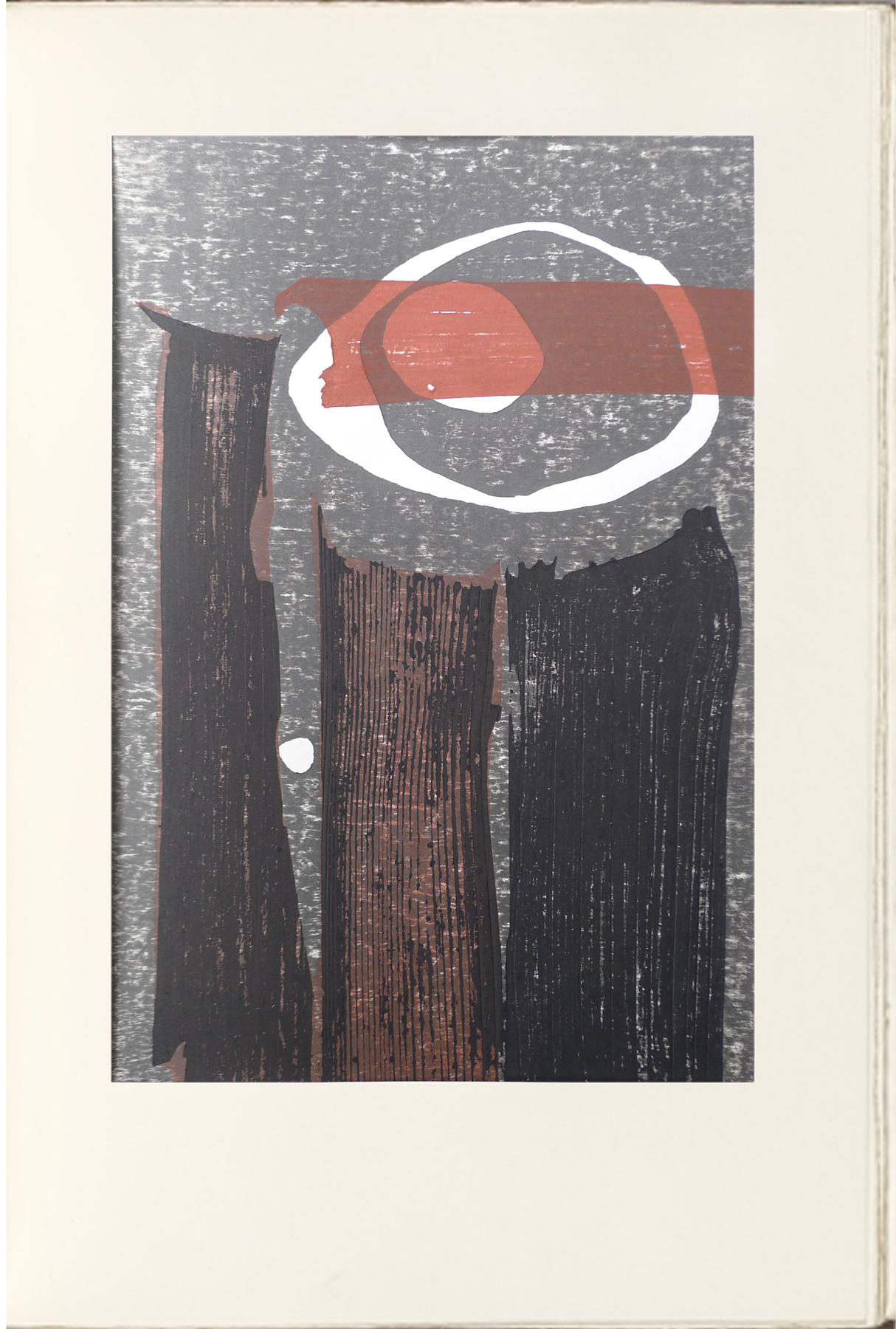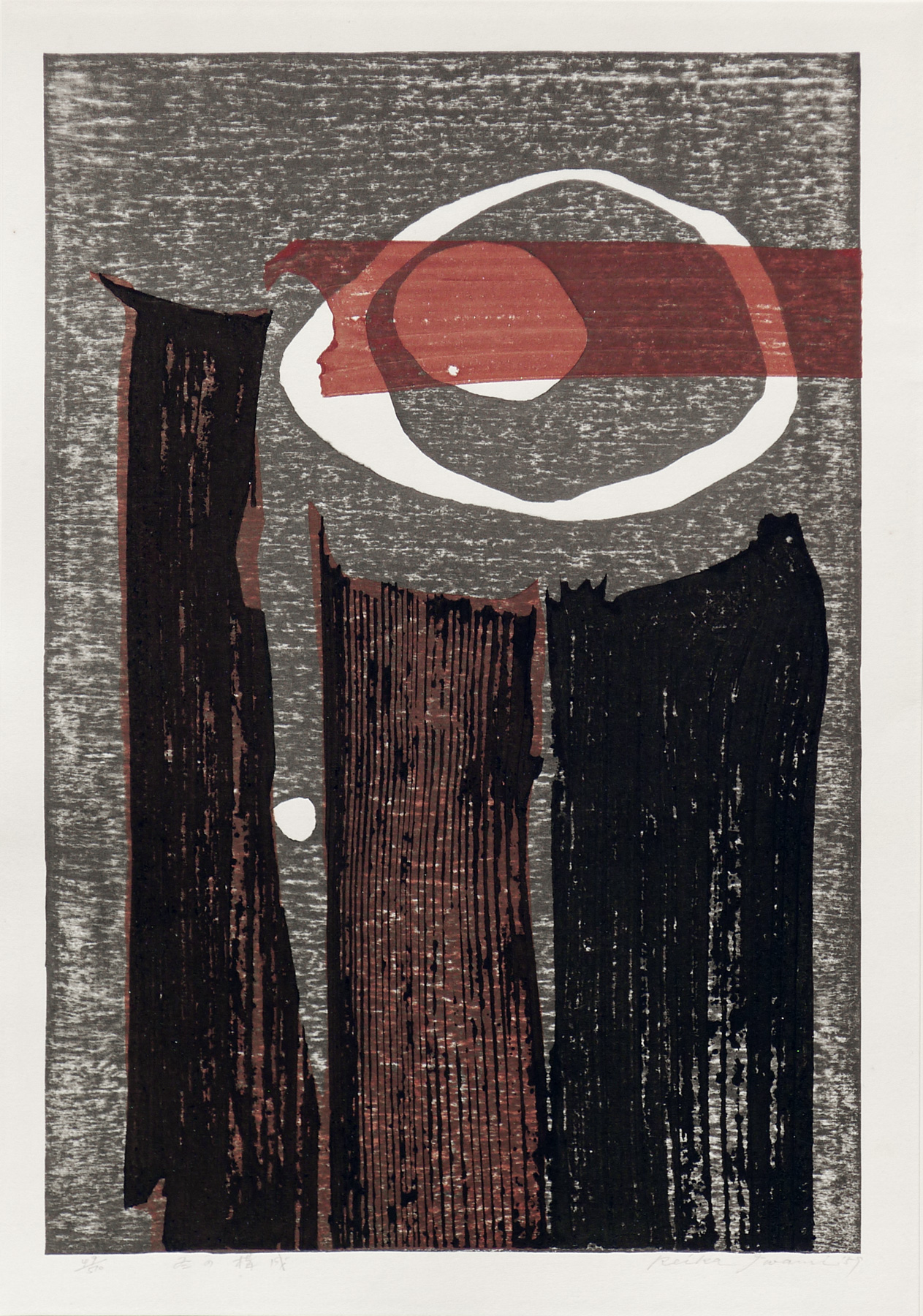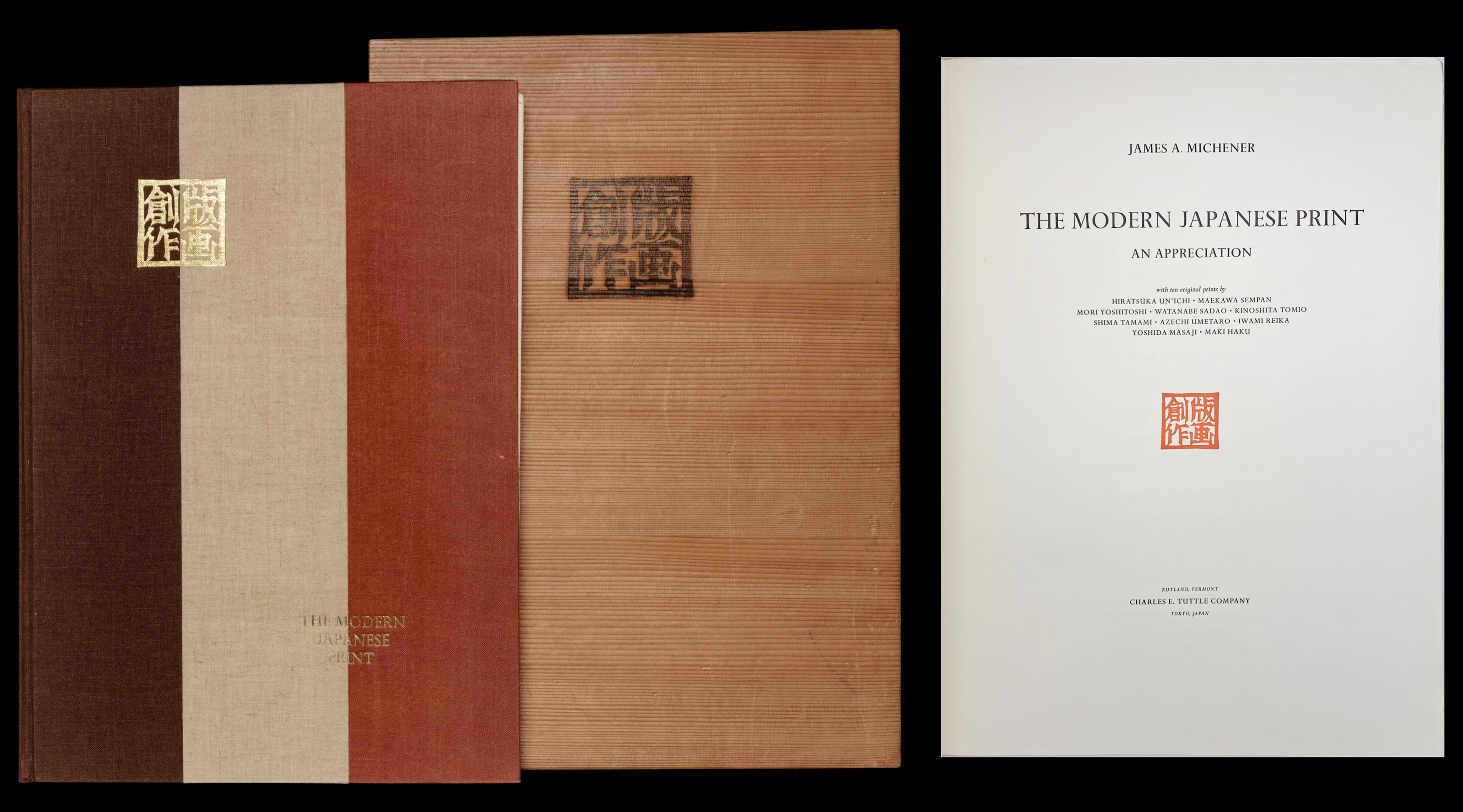One of ten modern prints by ten different artists chosen for James Michener’s 1962 seminal work and portfolio of prints The Modern Japanese Print: An Appreciation, a work that brought Iwami and the other artists to international attention.
"The Modern Japanese Print: An Appreciation" by James Michener
Note: Each print is tipped into Michener's book and placed under a mat that covers its margin, hiding the artist's signature, the print's title and the edition number on most of the prints.
IHL Cat. 1336
James A. Michener, The Modern Japanese Print: An Appreciation, 1962
Bound book with ten original prints by Hiratsuka Un'ichi, Maekawa Senpan,
Watanabe Sadao, Kinoshita Tomio, Shima Tamami, Azechi Umemtarō*,
Iwami Reika,Yoshida Masaji, Maki Haku and Mori Yoshitoshi,
housed in a wooden slipcase
(* This collection's book is missing the prints by Azechi Umemtarō and Yoshida Masaji.)
This print is special in many ways. First of all, it was done my Miss Iwami Reika, the first woman in the history of Japanese prints, so far as I know, to attain full stature. It is true that Hokusai's daughter, an extraordinary girl known by the name of Chin-chin because her protruding jaw reminded one of the Pekinese dog (called chin in Japanese), issued a few works that gained wide circulation in the middle years of the nineteenth century; but she was never really much more than a curiosity, and her work was in no way commendable. It is also true that today there are other fine women print artists who are gaining increasing recognition - Shima Tamami and Yoshida Chizuko, to name only two - and that there are now enough of them to have an informal association and to hold periodic exhibits of considerable worth. But Miss Iwami represents the vanguard, and for two women to win prizes in a competition such as the present one signalizes a triumph of no small proportion. It has never been easy for women to attain prominence in Japanese art, and for two such young ones to have done so is indeed an accomplishment. More important, artistically, however, is the second fact: this print exhibits a mastery of texture and color that is enviable. The utilization of wood grain in the three standing pillars is very satisfying and gives the print a surcharge of emotion. The printing of this passage and also of the background grays is first rate, skillful overprinting being used to bring out unanticipated textures. In others of her prints, Miss Iwami uses a striking palette of burnt orange, crisp yellow, and flashing red. Here she is more subdued, but her vivid sense of color values nevertheless expresses itself in the telling slash of red across the moon.The third reason why this print has a special significance in this series is that it exemplifies rather handsomely the best effects that are being obtained by the nonrepresentational artists in simplifying subject matter to the ultimate. What more need by said about winter in Japan, where the wonderful texture of the unpainted wooden houses stands so starkly against the cold sky? The resulting patterns are most satisfying, emotionally, and many people who have had an opportunity to live closely with others of Miss Iwami's prints can testify to the subtle gratifications one discovers in having them around. They are somehow right; both the eye and the mind find them recurrently pleasing, and thus they satisfy one of the great purposes of art: they remind us of how simple the most effective measures usually are. Miss Iwami utilizes simple means, simple design, simple, bold coloring, and out of this produces a complex, sophisticated whole that has the capacity to please without cloying.The final characteristic of this print that makes it special for me is that it was done by an artist whom I had the pleasure of helping discover. All the men represented in this book were well-established performers before I came on the Tokyo scene. Hiratsuka was producing fine prints before I was born, and Maekawa too. Azechi was well into his third period - the portraits of mountaineers against stylized peaks - before I met him; and each of the other artists was well known. But Iwami Reika was not.1
This is one of two prints by the same title; I personally prefer the No. 1. Since the deadline for the contest was the 1st day of December, I picked the theme of winter for my compositions. It was partly with a feeling of resistance against the cold and cruel impression of winter that I worked on these prints. What I wanted to express, however, was that even though winter is cold and severe, it is at the same time secretly nursing the buds of hope.2
1 The Modern Japanese Print - An Appreciation, James Michener, Charles E. Tuttle Co., 1968, p. 44-45.
2 Ibid., p. 46.
3 Ibid.
Print Details
last revision:
| IHL Catalog | #895 and #1336g |
| Title | Winter Composition No. 2 冬の構成2 Fuyu no Kōsei 2 |
| Artist | Iwami Reika (1927-2020) |
| Signature |  Reika Iwami (pencil signature lower right bottom margin followed by date) |
| Seal | not sealed |
| Date | 1959 |
| Edition | IHL Cat. #895: 49/510 IHL Cat. #1336g: 463/510 (475 of the edition were included in the original 1962 limited edition of The Modern Japanese Print – An Appreciation by James Michener) |
| Publisher | Charles E. Tuttle Company, Tokyo |
| Carver | self-carved |
| Printer | self-printed |
| Impression | IHL Cat. #895 and #1336g: excellent |
| Colors | IHL Cat. #895 and #1336g: excellent |
| Condition | IHL Cat. #895 and #1336g: excellent |
| Genre | sosaku-hanga (creative print) |
| Miscellaneous | |
| Format | dai-ōban |
| H x W Paper | IHL Cat. #895: 17 1/4 x 12 1/8 in. (43.8 x 30.8 cm) IHL Cat. #1336g: 17 1/4 x 12 1/8 in. (43.8 x 30.8 cm) |
| H x W Image | IHL Cat. #895: 15 3/4 x 10 3/4 in. ( 40 x 27.3 cm) IHL Cat. #1336g: 15 3/4 x 10 3/4 in. ( 40 x 27.3 cm) |
| Collections This Print | Portland Art Museum 2004.39h (bound in the book The Modern Japanese Print by James Michener); The British Museum 1981,0205,0.1.8 (61/510); TheNickle Arts Museum, University of Calgary 1968.064.008 (354/510); Museum of Fine Arts, Boston 63.461; Brooklyn Museum 63.15.8; Honolulu Museum of Art 14941; Philadelphia Museum of Art 1964-201-1(8) |
| Reference Literature | The Modern Japanese Print: An Appreciation, James A. Michener, [with Ten Original Prints by Hiratsuka Un'Ichi, Maekawa Sempan, Mori Yoshitoshi, Watanabe Sadao, Kinoshita Tomio, Shima Tamami, Azechi Umetaro, Iwami Reika, Yoshida Masaji, Maki Haku], Rutland, Charles E. Tuttle Company, 1962; The Modern Japanese Print - An Appreciation, James Michener, Charles E. Tuttle Co., 1968 [the "popular edition"]; The Legacy of Japanese Printmaking, Barry Till, Art Gallery of Greater Victoria, 1986, p. 94. |
8/30/2021




